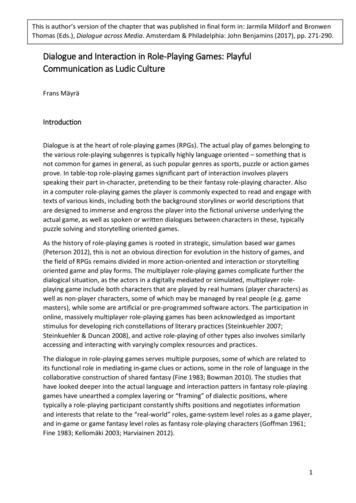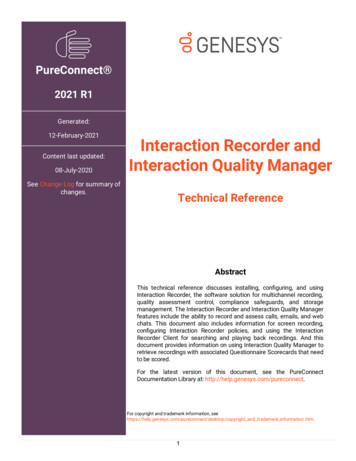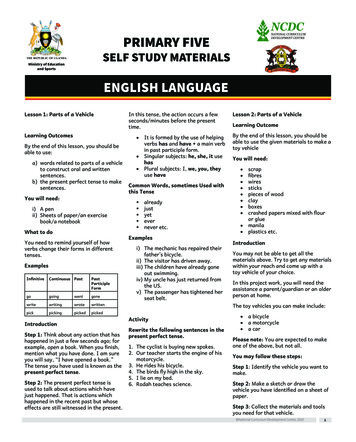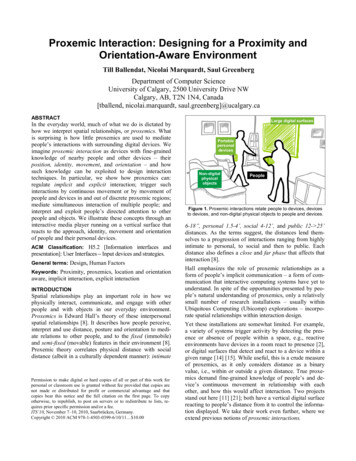
Transcription
This is author’s version of the chapter that was published in final form in: Jarmila Mildorf and BronwenThomas (Eds.), Dialogue across Media. Amsterdam & Philadelphia: John Benjamins (2017), pp. 271-290.Dialogue and Interaction in Role-Playing Games: PlayfulCommunication as Ludic CultureFrans MäyräIntroductionDialogue is at the heart of role-playing games (RPGs). The actual play of games belonging tothe various role-playing subgenres is typically highly language oriented – something that isnot common for games in general, as such popular genres as sports, puzzle or action gamesprove. In table-top role-playing games significant part of interaction involves playersspeaking their part in-character, pretending to be their fantasy role-playing character. Alsoin a computer role-playing games the player is commonly expected to read and engage withtexts of various kinds, including both the background storylines or world descriptions thatare designed to immerse and engross the player into the fictional universe underlying theactual game, as well as spoken or written dialogues between characters in these, typicallypuzzle solving and storytelling oriented games.As the history of role-playing games is rooted in strategic, simulation based war games(Peterson 2012), this is not an obvious direction for evolution in the history of games, andthe field of RPGs remains divided in more action-oriented and interaction or storytellingoriented game and play forms. The multiplayer role-playing games complicate further thedialogical situation, as the actors in a digitally mediated or simulated, multiplayer roleplaying game include both characters that are played by real humans (player characters) aswell as non-player characters, some of which may be managed by real people (e.g. gamemasters), while some are artificial or pre-programmed software actors. The participation inonline, massively multiplayer role-playing games has been acknowledged as importantstimulus for developing rich constellations of literary practices (Steinkuehler 2007;Steinkuehler & Duncan 2008), and active role-playing of other types also involves similarlyaccessing and interacting with varyingly complex resources and practices.The dialogue in role-playing games serves multiple purposes, some of which are related toits functional role in mediating in-game clues or actions, some in the role of language in thecollaborative construction of shared fantasy (Fine 1983; Bowman 2010). The studies thathave looked deeper into the actual language and interaction patters in fantasy role-playinggames have unearthed a complex layering or “framing” of dialectic positions, wheretypically a role-playing participant constantly shifts positions and negotiates informationand interests that relate to the “real-world” roles, game-system level roles as a game player,and in-game or game fantasy level roles as fantasy role-playing characters (Goffman 1961;Fine 1983; Kellomäki 2003; Harviainen 2012).1
The aim of this chapter is to identity the multiple roles dialogue has in role-playing games,and provide illustrative examples and analyses of dialogue in different types of role-playinggames. The examples are chosen also to highlight the similarities and differences betweenthree key RPG forms, table-top (also known as pen-and-paper) RPGs, single-player computerRPGs and multiplayer, online computer role-playing games. It should be noted that liveaction role-play (larp) is excluded from this discussion, being so rich and diverse field torequire a special treatment of its own. From this chapter, the reader should both learn toappreciate the diversity of role-playing games as an innovative form of language use, as wellas to identify the many dimensions and functions that interaction that combines languagewith gameplay action holds at the social levels of play situation, in various game systemlevel interactions as well as in the construction of in-game characters and fantasy worlds.Multiple Levels of Dialogue in Table-Top Role-Playing GamesThe dialogic nature of role-playing games can be approached from several perspectives, themain ones relating to them being game systems on one hand, and play activity on the other.As games, the dialogic nature of games is rooted in their interactive fundamental structure.The dynamic structure of something that is designed to be a game typically involves variouschallenges that the players of the game try to overcome. The “classic game definition” thatJesper Juul has synthesized on the basis of several earlier studies has six key elements that aproper game should include: games are (1) rules-based systems, with (2) variable andquantifiable outcomes, where (3) different outcomes are assigned different value, and the(4) player needs to exert effort in order to influence the outcome, while also (5) beingattached to the outcome, and (6) the consequences of game play need to be negotiable.(Juul 2005, 36.)This manner of approaching games inevitably mixes elements that are (formal)characteristics of games as textual or media systems, with the (informal) characteristics howgames are intended to be played and enjoyed. The negotiable consequences, for example,emphasise that games are typically designed for entertainment purposes, and “real worldconsequences” such as loss of money, stature or even one’s life are not usually consideredparts of proper game playing. Cultural historian Johan Huizinga in his Homo Ludens(1938/1955, 13) claimed that all true play is activity that is not connected to any materialinterest, and that no profit can be gained by it. Nevertheless, there are professional playerswho gain monetary rewards from their playing, and in the case of gambling, it is preciselyhaving real money (as contrasted to “play money”) on the table that provides this gametype with its particular, tempting and perhaps even dangerous character. However, ifgaining money and making profit are the only reasons for the design and use of a particularsystem, then it is typically designed to be much more utilitarian and instrumental bycharacter. While work and play can mix, designs of tools for work generally tend to differfrom the designs of games, or toys. There is built-in dynamics of use that is meant to beinherently enjoyable in games, and game play can be an end in itself, whereas tools aredesigned to be means towards some (external) end; game designer Greg Costikyan (2002)2
has discussed this as the “endogenous meaning” of games as systems. AnthropologistGregory Bateson (1955) on the other hand had observed young animals play-fighting and heintroduced the concept of “metacommunication” for various ways in which the playerscommunicate how a “playful bite” should be interpreted in a different contextual framefrom that of “real bite.”It is within this more general context of playful frames and ambiguous “playthings” whererole-playing games also came into being. The history of role-play and role-playing games iscomplex and forks into multiple directions. The most common historical narrative derivesRPGs’ origins primarily into the first published commercial role-playing game system:Dungeons and Dragons (D&D; TSR, 1974). This on its part was deeply anchored in longhistory of wargaming, which often involved the use of miniatures to mark military units thatwere then manipulated according to rules for playful simulation of battle. D&D changed thisbasic setting for providing each player with a single player character to control, and thenexpanding the play situation into much more storytelling and drama oriented simulation ofevents in an alternative reality. A “Dungeon Master” (DM) acts as the referee and also playsout the actions and dialogue of non-player characters – including the fantastic monsters andmythical beings that player characters often face in a typical D&D fantasy scenario. Whilethe early wargames in the eighteenth century were designed as tools for military trainingand tactical exercise, a role-playing game like D&D is driven by different motivations of use.(Barton 2008; Peterson 2012.)Dungeons and Dragons will be used next to showcase the various dimensions or aspects ofdialogue that inform table-top role-playing games in particular. The main dimensions thatwill be discussed here include dialogue around the world and character creation, dialoguethat relates to game play, and negotiated dialogue that takes place between playercharacters, in the diegetic frame of in-game fiction. The discussion of game frames reliesprimarily here on frame analysis, pioneered by Erving Goffman (1961; 1974) and itsapplication to the study of role-play games as “shared fantasies” by Gary Alan Fine.Following and applying Goffman’s thought, Fine distinguished between the primaryframework (which covers all non-diegetic frames), game frame where players interact witheach as regulated by the game system’s rules, and, thirdly, the frame of player characters,which is the domain of in-game, diegetic fiction (Fine 1983, 186). It is important to note thatthe basic character, goals and understanding of the role-playing situation can change,depending on which of these three frames is highlighted – or “up-keyed” in Goffman'sterminology. Fine emphasises that the fantasy frame provides each player characterdistinctive identity of their own, in manner that differentiates role-playing game from othergames, such as chess; it would make no sense to discuss information or intentions thatindividual chess piece would have, for example. In fantasy role-playing game, the playercharacter has distinctive set of features, abilities and “life goals” that should not beconfused with the player goals. In reality, this boundary line is not so easy to maintain,though.This basic layering of a role-playing game is perhaps best highlighted when it becomesdebated and a source of conflict in the actual practices of role-player community. TheUSENET discussion forum “rec.games.frp.advocacy” featured such intense discussion during3
the summer of 1997. There were different role-playing styles and priorities among thepractitioners that often became source of disagreement. It was in the “Threefold Model”document that was compiled as the summary of the discussion where three basic goals forrole-playing were identified: Drama, Game and Simulation (Kim 1998). The model reducesthe ways in which players negotiate the different layers of role-playing situation into threefundamentally different interpretations about goals of RPGs, which in its turn gives birth todifferent playing styles that are then agreed upon by the gaming group in their (sometimesexplicit but most often implicit) “game contract.” A ‘dramatist’ playing style “is the stylewhich values how well the in-game action creates a satisfying storyline”, a ‘gamist’ playingstyle emphasises the role of challenges and fair ways of solving them, whereas‘simulationist’ style values above all the internal consistency of the diegetic game world, andemphasises that in-game events should be influenced only by “game-world considerations”(ibid.). Comparing the three alternatives to the RPG frames Fine had identified, it could besaid that for one faction of players, a role-playing event is primarily organised in order to theparticipating (real) people to have fun and entertaining social interaction together(‘dramatists’), the second group is participating to play a game, to solve a puzzle and masterthe rule-based game system (‘gamists’), and the third group perceives the character frameand the in-game fantasy world as the main priority (‘simulationists’). It should be noted thatthe playing styles do not necessarily define the player: it is perfectly possible to prefer onestyle in the context of one game, and change the preference while moving to anotherplaying context.In addition to there occasionally being disagreements between different game players onhow the role-playing event should be organised, there are also important dividing lineswithin the level of a single player. Fine notes (ibid., 188) that “player, person, and charactershare a brain”, and provides examples of how the actions of fantasy game characters areinfluenced by the real-world knowledge that the person behind the character has (but thefantasy character strictly speaking should not have access to), and of how players' systemlevel information about the game situation can also “leak” into the game world andinfluence character’s actions. The dialogue between players and the referee (“DungeonMaster”) often involve negotiations about which information will be allowed to becomeparts of the shared, diegetic in-game reality:Barry: I'm going to see my father in the Great While Lodge [a magical lodge thatother characters have mentioned, and which he knows about as a player – but not asa character – of which his father is the leader].George: You don't know anything about the Great While Lodge.Barry: I’ve heard about it.George: Well, you might have heard about it.Barry: In mythology, you know.George: That’s about all you’ve heard. You don't even know there is a leader there.Barry: Yes, I do.GAF: You certainly don’t know it’s your father.Barry: No, but I always wanted to see him.George: Well, but everybody wants to see someone important. That doesn’t meananything.4
(Gary Alan Fine’s field notes; Fine 1983, 190-91.)The actual dialogue in a table-top role-play situation can develop into much more complexforms than in this above example. In addition to several players discussing about rules(game system level interpretations), or enacting direct or indirect speech of on behalf oftheir player characters, there might also be elements of speech that relate to the actual, offgame reality. This has been analysed by Johannes Kellomäki (2003), who has further dividedthe player frame into the frame (or level) of actual player and frame of surrogate player,who is responsible for managing the role-playing narration. According to this analysis, atable-top role-playing situation has four levels of interaction and dialogue (see below, Figure1).Level ofsocialinteractiongeneralsocialconventionsLevel ofrole playingmember ofthe societyrole playingcontractLevel ofnarrationactual playerconventionsof narrationLevel ofcharacterssurrogateplayersocialconventionsof thenarratedrealitycharacterEach outer level includes the more internal levels.Figure 1: the interaction layers in role-playing game (according to Kellomäki 2003, 34; FM’stranslation from Finnish).These four levels where role-playing dialogue can be positioned can be illustrated with atransliterated sample of actual table-top role-playing game session:A: Is it dark?K: Now it is like evening dusk. Throw two times ‘eyesight’.(J, A and T throw dice)J: ‘Marginal success’.A: Easily succeeds.K: Ok, so you can see. Because there are really.T: Fails.K: three ships approaching.-K: He says, this Valas, like, says that this is not probably a question of any vendettahere any more. I think that those surely do not look anything like the ships ofSherwyn. Let it be said that there is something else going on here.T: Yes.K: Wait a minute. My papers are always like mixed up somehow.5
A: Who has been reading the IT Week magazine again? (laughs)J: It was me. (laughs)(Kellomäki 2003, 29; FM's translation from Finnish.)The speech in bold in the above sample refers to common, everyday social interaction,where players are in “off-game” mode, interacting with each others as real-world friends,not as game players. The underlined speech, on the other hand is taking place within thelevel of actual game play: the comments about ability checks and dice throw results, forexample, communicate information between players and the game master that maintainand change the game state, according to the rules of this role-playing game. The discussionabout dice does not, however, take place within the diegetic, in-game domain of fiction thatgame characters inhabit. This is interaction between ‘actual players’ who need to orienttheir actions according to the facts of game system, represented here by the ‘eyesight’ability test and results from the associated throws of dice. The next level (non-marked in thesample) is one of surrogate players, which can be likened to the distinction between actualspeaker and substitute speaker (and hearer) in Marie-Laure Ryan’s theory of fictionalcommunication (Ryan 1991, 74-76). The narrative reality of game world in a role-playinggame is largely constructed in this level of communication. The game master (or DungeonMaster, in D&D games) has much power to utter speech acts that immediately take thestatus of facts in the imaginary world of role-playing fantasy (“there are three shipsapproaching” in the sample). The fundamentally interactive character of role-playing game,however, allows multiple actors to have their say on how events proceed. Dice are thrown,rule systems are interpreted, and the final outcome in the role-playing event is subject ofnegotiation. It is perfectly possible for players to protest, and question game master’s initialjudgement, like Barry did in the above sample recorded by Fine.The final level (or frame) that is featured in italics in Kellomäki’s transliterated sample is thelevel of character speech. The player characters and non-player characters such as helpfulvillagers or intelligent fantasy monsters can interact at this level of “acted speech” – whichcan also often be indirect, reported speech (“Valas says that this is not probably a questionof any vendetta here any more”). Consequently, the table-top role-playing dialogue appearsrather complex and rich form of speech, considering also that all these different levels ofdiscourse take place in tightly interwoven ways, and in some cases a single utterance cantake place in several levels at one. This is illustrated in the sample by K saying “Wait aminute. My papers are always like mixed up somehow”, which is both directed towardshandling the game system level events and the associated “papers” such as charactersheets, maps and player notes, but is also partly a personal, off-game comment. Themultiple frames or levels of dialogue identifiable in a table-top role-playing game situationserve as a point of comparison as we move next to analyse dialogue in computer roleplaying games.Computer Role-Playing Games: Rule-Systems and Fiction6
Roger Caillois (1958/2001, 13; cf. Jensen 2013) has made the distinction in dividing gameplay according the axis between paidia and ludus, where paidia consists of improvisationaland free play form, whereas the ludus style of play is more formal and rule-bound. In roleplaying this duality is reflected in the design and use of role-playing rule-sets, or gamesystems, where other systems emphasise more free improvisation and interactivestorytelling, while others start from the basis that it is more fair for everyone that all keyevents are rather strictly resolved according to rule-systems and game mechanics such asthe use of dice. While there are diceless role-playing game systems, and rather free-form“storytelling games”, most contemporary table-top role-playing games balance informalnegotiation with some “strict” rules, which are meant to structure the game playing and (inthe form of dice or other randomizer tools) also to provide unpredictability to the ways inwhich events proceed. Accessing a mainstream, popular commercial game system one cantake a look for example at the D&D Player’s Basic Rules (version 0.3, available as a freedownload from the Wizards of the Coast website 1); the guidebook starts by emphasising therole of imagination, storytelling and fantasy world as the setting for D&D gameplay. Thethree key elements of RPG gameplay that D&D rulebook identifies are:1. The DM describes the environment.2. The players describe what they want to do.3. The DM narrates the results of the adventurers’ actions.These three stages in dialogue-based gameplay are then employed into the “three pillars ofadventure”, which the D&D rulebook lists as exploration, social interaction and combat.While the free-form and storytelling oriented game systems ostensibly provide much roomfor introducing spontaneous, improvised elements of fantasy into the collective narration,there are always some kinds of limits and implied, if not explicit rules for what kinds ofactions and general tone the shared creation should be based on. For example, the D&Drulebook explicitly notes that social interaction should be role-played in a manner thatshould be informed by elements such as character classes (which are sort of fantasyadventurer professions), characteristics of fantasy races (orcs should be played differentlyfrom elves, or dwarves), and the rules that dictate how the ability scores and variousmodifiers (as recorded in the player’s character sheet) affect what a game character can do,what her motivations are, and how other characters are likely to react to her. If the roleplaying game is set into a complete fantasy campaign world, such as the “Forgotten Realms”of TSR/Wizards of the Coast, then the geography, history, mythology and cultures ofpeoples inhabiting it become a major player in directing the ways in which player charactersare able to interact with each other, and with the world they inhabit.In a digital role-playing game, the opportunities and conventions for dialogue areunderstandably rather different from face-to-face game play. While there existsconsiderable tradition of work directed at analysing digital, computer-mediatedcommunication, and live action as well as table-top role-play have also received their fairshare of scholarly attention during recent years, the analysis of computer role-playinggames (CRPGs) has taken perhaps a bit secondary role in research. The evolutionary historyof computer CRPGs itself is rather well documented in various, both popular as well as moreacademic accounts (e.g. King & Borland 2003; Barton 2008). As the single-player CRP lacks7
negotiation between human players, both its dialogue, storytelling and action are structureddifferently from table-top role-playing games. While many accounts position centrality ofplayer character and character development at the heart of CRPs as a genre, a “character”in computer-based role-play has typically more instrumental role than in more fantasy andimprovisation oriented table-top or live role-playing forms. Jon Peterson (2012, 369) noteshow already the early experiments in RPG design tried different alternatives on howindividual player characters could have a “personality”, turning to quantified andmeasurable “abilities” as the key solution. There is nothing in the original published systemof Dungeons and Dragons (1974) that would encourage the players to aim for “deeperidentification” with their characters, as Peterson notes – indeed, according to him, the term‘role-playing’ does not appear in the initial edition of Dungeons & Dragons at all (ibid., 371).Thus, the computerized versions of role-playing games in their early forms did not need toventure very far from how the classic, D&D style RPG systems were built: their programmingcode aimed to implement spatial simulation of a fantasy world, combined with a storyline ofevents (typically organised into a series of puzzles, or larger “quests”), a developing playercharacter(s) and her inventory of accumulated items. Nevertheless, dialogue remainsimportant part of CRPGs, as it is in their table-top counterparts.Already the earliest computer adventure games featured elements of gaming fantasy thatlink them to the legacy of D&D and other role-playing games. The ADVENT (or “ColossalCave Adventure” as it is also known), the earliest known text text adventure game,programmed by William Growther in 1975-1977, was partially based on a real-worldMammoth Cave system in Kentucky, partly relying on fantasy conventions, such asintroducing magic weapons, and fantasy races such as dwarves (Jerz 2007). Technically, thecentral part of dialogue in text adventure games, and in early computer role-playing gamesthat followed them was the textual exchanges that player carried out through parser, thesoftware that interprets natural language input. In early games, software could onlyunderstand simple verb-noun constructions like “go inside”, “open door”, or “get key”. Thesoftware is programmed to respond by describing environment, consequences of action, orcharacter speech. In later text adventure games and contemporary interactive fiction, theuser input can consist of much more complex sentences and the artistic and technical rangeof possibilities for expression are consequently also larger. (Montfort 2003.) The computerrole-playing games diverged from evolution of interactive fiction by their pronouncedemphasis on quantified improvement, or “levelling up” of characters through accumulationof experience and treasure, making the characters more capable of encountering harderchallenges and opponents.The early single-player computer role-playing games were constantly pushing against thelimitations of available technology. For example, Pool of Radiance (TSR/SSI, 1988) came witha printed booklet, “Adventurer’s Journal”, which included longer texts and images ofposters, maps and other information that players (and characters) came across in the gamebut which could not reasonably be reproduced on home computers in the late 1980s. Inrelevant parts of the game, an instruction on screen advised player to refer to an element oranother of that kind in the Journal. The in-game descriptions and dialogue displayed in thelow-resolution computer screen of the time typically consisted only of few lines of text, inaddition to character statistics and a small graphical window that in the “exploration mode”8
displayed a first-person view into the game world. A standard encounter with a non-playercharacter (NPC) might involve display of the graphical image of the NPC, e.g. the HarborMaster of New Phlan (a city in Forgotten Realms fantasy world), and text output: “TheHarbor Master tells you boats leave for the west, the east, Sokal Keep, and the north side ofthe Bay. ‘Round trip passage is 1 platinum piece. What passage can I sell you?’” The playerinteraction is provided here through the keyboard, with the lower part of the screendisplaying a menu of highlighted shortcut keys (s, e, w, b, and none) to inform the playerabout the available alternatives (buying trip to Sokal, east, west, or Bay).A decade later, both the computer technology and game design had advanced to the pointthat allowed enhanced control and interaction at the level of game mechanics, as well asexpanded opportunities for game engines to provide more support for dialogue andaudiovisual storytelling. Baldur’s Gate (BioWare, 1998) is a highly successful computer roleplaying game of the era, and provides examples of both the advances as well as certainremaining limitations in CRPG design. Right from the start, Baldur’s Gate is heavy withtextual material, which is typically also accompanied by voice narration and pre-scripted(non-interactive) cutscenes. A starting player is first in the game provided with the longanimated cutscene where a mysterious armoured figure attacks and kills a helpless victim inthe dark of the night. The scrolling, long text of Prologue is also provided, accompanied bynon-diegetic voice-over, informing the player that her character is an orphan, growing up inthe city of Candlekeep in the world of Forgotten Realms. The storyline underlying the actualgameplay is set into motion through Prologue’s hints of player character’s mysterious past,and recounting of ominous signs of some danger approaching. Following next is a keyelement where the player is able to influence the way the CRPG unravels: the charactergeneration, where player is provided freedom to choose the name, gender othercharacteristics, such as “alignment” of her character. In the applied “AdvancedDungeons&Dragons” (AD&D) game system these range from “lawful good” to “chaotic evil”,reflecting the moral consistency and ethical orientation that the character is supposed tofollow in her fantasy world adventures.Baldur’s Gate was created using new game technology, carrying the name “Infinity Engine”.The promise of such graphical game engine and the new generation of CRPGs was focusedon enhanced opportunities for “immersion” – imaginative, audiovisual and fluently flowingaction, all designed to transport the player into alternative, fantasy universe. Whileextensive and highly-detailed sensorial simulations of alternative, game world support suchimmersion to a certain degree, it is the actual playing of the game, and degree of engaginginteractivity that it is able to provide that dominates the experience of most game players(Ermi & Mäyrä 2007). In the table-top role-playing situation, player is basically limited onlyby her imagination, verbal abilities and the (implicit or explicit) role-playing contract thatsets the frame for fantasy role play among this group of players. Baldur’s Gate and itsInfinity Engine allows the player to move the player character around the game world easilythrough the point-and-click graphical interface; the immediate environment is presentedfrom “pseudo-3D”, top-down perspective, allowing the player to initiate various actions andexplore the world through the player character. The move from text parser based interfacesto the more graphics oriented environment however was also linked to lesser emphasisbeing put to text input. The amount and quality of dialogue available in Baldur’s Gate is9
considerably enhanced from an early CRPG like Pool of Radiance, but the actual degree ofinteractivity in dialogic exchange is limited to player using mouse (or a keyboard shortcut) tochoose from pre-scripted alternatives. Baldur’s Gate also provides an example of how realtime action is becoming the norm also in CRPGs. While the dialogue adds flair and struc
and tactical exercise, a role-playing game like D&D is driven by different motivations of use. (Barton 2008; Peterson 2012.) Dungeons and Dragons will be used next to showcase the various dimensions or aspects of dialogue that inform table-top role-playing games in particular. The main dimensions that










